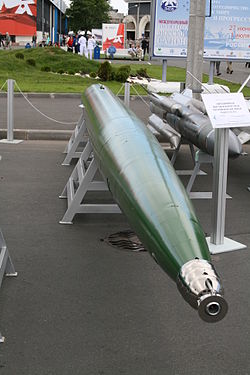Original: VA-111 Shkval
From Wikipedia, the free encyclopedia
| VA-111 Shkval | |
|---|---|

VA-111 Shkval
| |
| Type | Supercavitating Torpedo |
| Place of origin | Russia |
| Service history | |
| In service | 1977-present |
| Used by | Russian Navy |
| Production history | |
| Designed | 1960s-70s |
| Specifications | |
| Weight | 2,700 kg (6,000 lb) |
| Length | 8.2 m (26 ft 11 in) |
| Diameter | 533 mm (21 in) |
| Effective firing range | Shkval: 7 km (4.3 mi) Shkval 2: From 11–15 km (6.8–9.3 mi) |
| Warhead | Conventional explosive or nuclear |
| Warhead weight | 210 kg (460 lb) |
| Engine | Liquid-fuel rocket (HTP andkerosene) |
| Speed | Launch speed: 50 knots (93 km/h; 58 mph) Maximum speed: in excess of 200 knots (370 km/h; 230 mph) |
The VA-111 Shkval (from Russian: шквал — squall) torpedo and its descendants are supercavitating torpedoes developed by the Soviet Union. They are capable of speeds in excess of 200 knots (370 km/h).[1]
Contents
[hide]Design and capabilities[edit]
Design began in the 1960s when the NII-24 research institute was ordered to produce a new weapon system capable of combating nuclear submarines. In 1969, the GSKB-47 merged with NII-24 to create the Research Institute of Applied Hydromechanics in Kiev, Ukraine (constructor Merkulov); the Shkval being a product of this merger.
Announced as being deployed in the early 1990s, although previously operational as early as 1977,[1] the Shkval is designed as a countermeasure against torpedoes launched by undetected enemy submarines. It may also be used as a counter to incoming torpedoes whereby it is launched at the enemy submarine, forcing it to evade, and hopefully cutting the guidance wire to the enemy torpedo in the process.
The speed of the VA-111 far exceeds that of any standard torpedo currently fielded by NATO. This speed is a result ofsupercavitation: the torpedo is, in effect, flying in a gas bubble created by outward deflection of water by its specially shapednose cone and the expansion of gases from its engine. By keeping water from coming into contact with the surface of the body of the torpedo, drag is significantly reduced, allowing extremely high speeds.
Launched from 533 mm torpedo tubes, the VA-111 exits the tube at 50 knots (93 km/h). Shortly afterwards, its liquid-fuel rocket ignites and propels it to speeds of up to 200 knots (370 km/h). Some reports indicate that speeds of 250+ knots may be achieved, and that work on a 300-knot (560 km/h) version was underway.[2] The rocket engine uses a combination of high test peroxide and kerosene; the propellant tanks contain about 1500 kg of hydrogen peroxide and 500 kg of kerosene.[3]
Early designs may have relied solely on an inertial guidance system.[4][5] The initial design was intended for nuclear warheaddelivery. Later designs reportedly include terminal guidance and conventional warheads of 210 kg (460 lb).[6]
The torpedo controls its direction using four fins that skim the inner surface of the supercavitation envelope. To change direction, the fin or fins on the inside of the desired turn are extended, and the opposing fins are retracted. To make faster turns, the push plate on the nose can be used to control the shape of the bubble the missile is traveling in.
Manufacture[edit]
The torpedo is manufactured in Kyrgyzstan by a state-owned factory. In 2012 the Russian government purchased a 75% ownership of the factory in exchange for writing off massive Kyrgyz debt to Russia. [7]
Specifications[edit]
There are at least three variants:
- VA-111 Shkval - Original variant; GOLIS autonomous inertial guidance.
- "Shkval 2" - Current variant; believed to have additional guidance systems, possibly via the use of vectored thrust, and with much longer range.
- A less capable version currently being exported to various third world navies. The export version is sometimes referred to as "Shkval-E"[citation needed] by Western analysts.
- Iran claimed it has created a version named Hoot.
All current versions are believed to be fitted only with conventional explosive warheads, although the original design used a nuclear warhead.
- Length: 8.2 m (26 ft 11 in)
- Diameter: 533 mm (21 in)
- Weight: 2,700 kg (6,000 lb)
- Warhead weight: 210 kg (460 lb)
- Speed
- Launch speed: 50 knots (93 km/h; 58 mph)
- Maximum speed: 200 knots (370 km/h; 230 mph) or greater
- Range: Around 11–15 km (6.8–9.3 mi) (new version). Older versions only 7 km (4.3 mi)[8]
Espionage[edit]
In 2000, former U.S. Naval intelligence officer and an alleged DIA spy Edmond Pope (Captain, USN, retired) was held, tried, and convicted in Russia of espionage related to information he obtained about the Shkval weapon system. Russian President Vladimir Putin pardoned Pope in December 2000, allegedly on humanitarian grounds because he had bone cancer.[9][10]
 RSS Feed
RSS Feed Twitter
Twitter Facebook
Facebook 9:53 PM
9:53 PM
 Kel
Kel


 Posted in
Posted in
0 comments:
Post a Comment